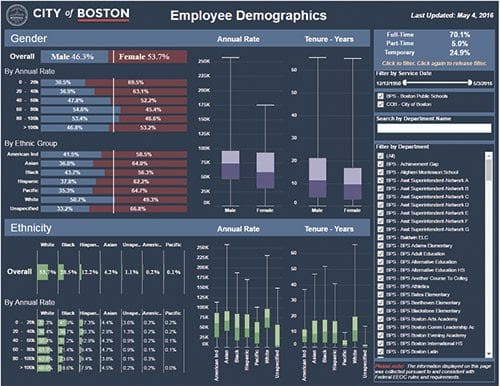
City officials released data last week detailing the diversity – and in many departments, lack of diversity – of the municipal workforce. The data shows whites and blacks are moderately overrepresented in city government while Latinos and Asians are underrepresented.
Whites, who make up 46 percent of the city’s population, represent 54 percent of the city’s workforce, according to the city’s Diversity Dashboard, an online interactive tool, that allows users to examine data for individual departments. Blacks, who make up 24 percent of the city’s population, constitute 29 percent of the city’s workforce. Latinos, at 29 percent of the city’s population, are just 12 percent of the municipal workforce. Asians, who are 9 percent of Boston’s population, occupy just 4.2 percent of city jobs.
Civil rights activists say the City of Boston has much work to do to build a workforce that reflects the growing racial and ethnic diversity of the city’s population.
“There needs to be a sense of urgency,” said NAACP Boston Branch President Michael Curry. “When the city’s workforce doesn’t represent its population, it’s a failure.”
Rahsaan Hall, Director of the Racial Justice Program at the ACLU of Massachusetts, noted that diversity is not evenly distributed in city departments.
“Of the 46 departments, there are only 9 of them that are at relative parity with the city’s population,” he said. “Some of the larger departments – the Police and Fire Departments – are well below parity.”
The data show that blacks, Latinos and Asians are concentrated in lower-paying jobs, with whites dominating the higher-paying departments like the Boston Fire Department, where 70 percent of the workforce is white. In that department, 341 of the 404 workers who earn more than $100,000 a year are white, 43 are black and 18 are Latino.
Similarly, in the Boston Police Department, 196 of the 237 employees earning more than $100,000 are white, 34 are black, and 5 are Latino. Just 22 percent of the 2,901 BPD employees are black, 9 percent are Latino and 2 percent are Asian.
The city’s Chief Diversity Officer, Daniel Tavares, acknowledged that the city’s workforce is not reflective of its diverse population.
“The numbers are misaligned across the board,” he said. “And if you remove BPS, the numbers drop even more.”
When jobs in the city’s school department are factored out, the white population of the city’s workforce inches up to 60 percent, while the percentage of blacks drops to 25 percent and the number of Latinos to 10 percent.
With the exception of Boston Public Schools jobs, where blacks and whites are at near-parity in pay, blacks and Latinos make considerably less in city jobs. That’s largely because, outside of BPS, blacks and Latinos are concentrated in the city’s lowest-paying jobs. Median pay for black city workers is $61,000 while for whites, it’s $74,900.
In the non-BPS departments with the highest concentrations of black workers – the Department of Youth Engagement and Employment (with 598 workers, 85 percent of whom are non-white), 460 of those workers – all black, Latino and Asian, earn less than $20,000 a year. Those numbers could reflect youth jobs, where teens earn less than $5,000 a year, but data was not broken down further.
Hall says the lack of diversity outside of the school department is concerning.
“In a city where the majority of people are people of color, the needs, concerns and education of these people are easier to ignore when the departments responsible for advocating their needs aren’t diverse,” he said. “Given the economic disparities that exist along racial lines, it’s all the more important to hire people who reflect the city’s population.”







